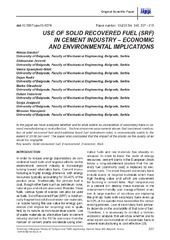Приказ основних података о документу
Use of solid recovered fuel (SRF) in cement industry: Economic and environmental implications
| dc.creator | Dondur, Nikola | |
| dc.creator | Jovović, Aleksandar | |
| dc.creator | Spasojević Brkić, Vesna | |
| dc.creator | Radić, Dejan | |
| dc.creator | Obradović, Marko | |
| dc.creator | Todorović, Dušan | |
| dc.creator | Josipović, Sonja | |
| dc.creator | Stanojević, Miroslav | |
| dc.date.accessioned | 2022-09-19T17:43:22Z | |
| dc.date.available | 2022-09-19T17:43:22Z | |
| dc.date.issued | 2015 | |
| dc.identifier.issn | 1451-4117 | |
| dc.identifier.uri | https://machinery.mas.bg.ac.rs/handle/123456789/2171 | |
| dc.description.abstract | In the paper we have analysed whether and to what extent co-incineration of secondary fuels in cement manufacturing is cost-effective. Techno-economic assessment shows that combined combustion of solid recovered fuel and traditional fossil fuel (petroleum coke) is economically viable to the extent of 20:80 per cent. The paper also concluded that the impact of the plants on the quality of air would be negligible. | en |
| dc.publisher | Institut za istraživanja i projektovanja u privredi, Beograd | |
| dc.rights | openAccess | |
| dc.rights.uri | https://creativecommons.org/licenses/by/4.0/ | |
| dc.source | Journal of Applied Engineering Science | |
| dc.subject | Solid recovered fuel | en |
| dc.subject | Risk | en |
| dc.subject | Environment | en |
| dc.subject | Economic | en |
| dc.title | Use of solid recovered fuel (SRF) in cement industry: Economic and environmental implications | en |
| dc.type | article | |
| dc.rights.license | BY | |
| dc.citation.epage | 315 | |
| dc.citation.issue | 4 | |
| dc.citation.other | 13(4): 307-315 | |
| dc.citation.rank | M51 | |
| dc.citation.spage | 307 | |
| dc.citation.volume | 13 | |
| dc.identifier.doi | 10.5937/jaes13-9574 | |
| dc.identifier.fulltext | http://machinery.mas.bg.ac.rs/bitstream/id/940/2168.pdf | |
| dc.identifier.scopus | 2-s2.0-84956674908 | |
| dc.type.version | publishedVersion |


